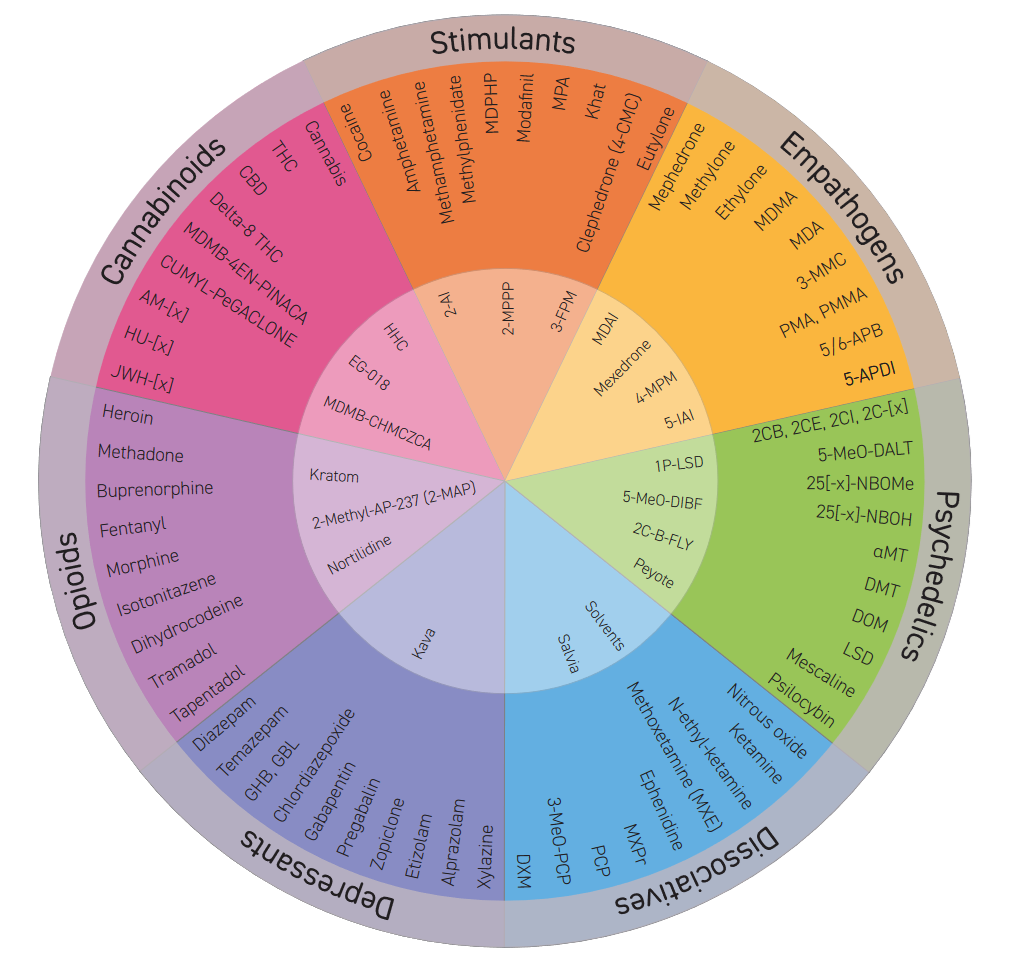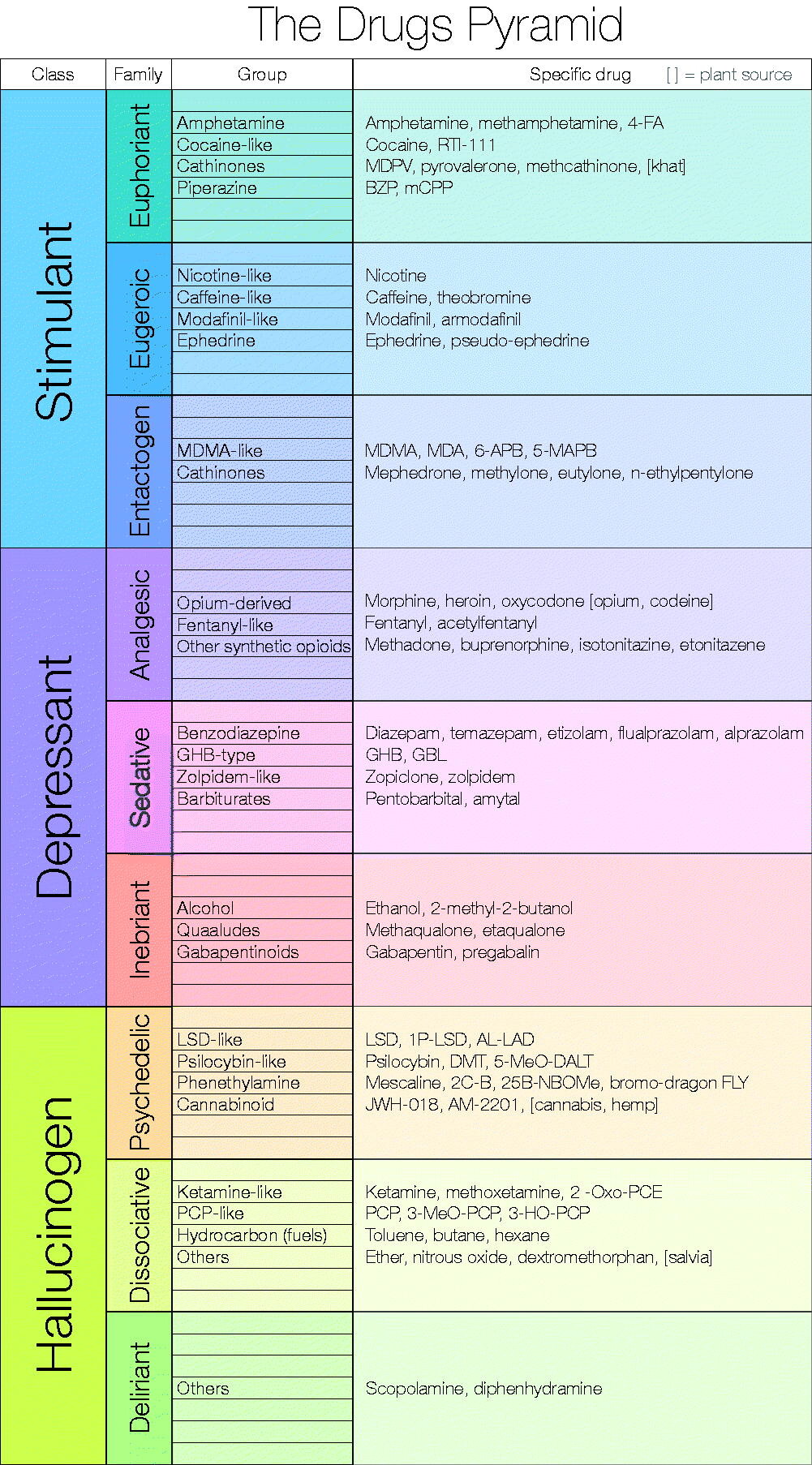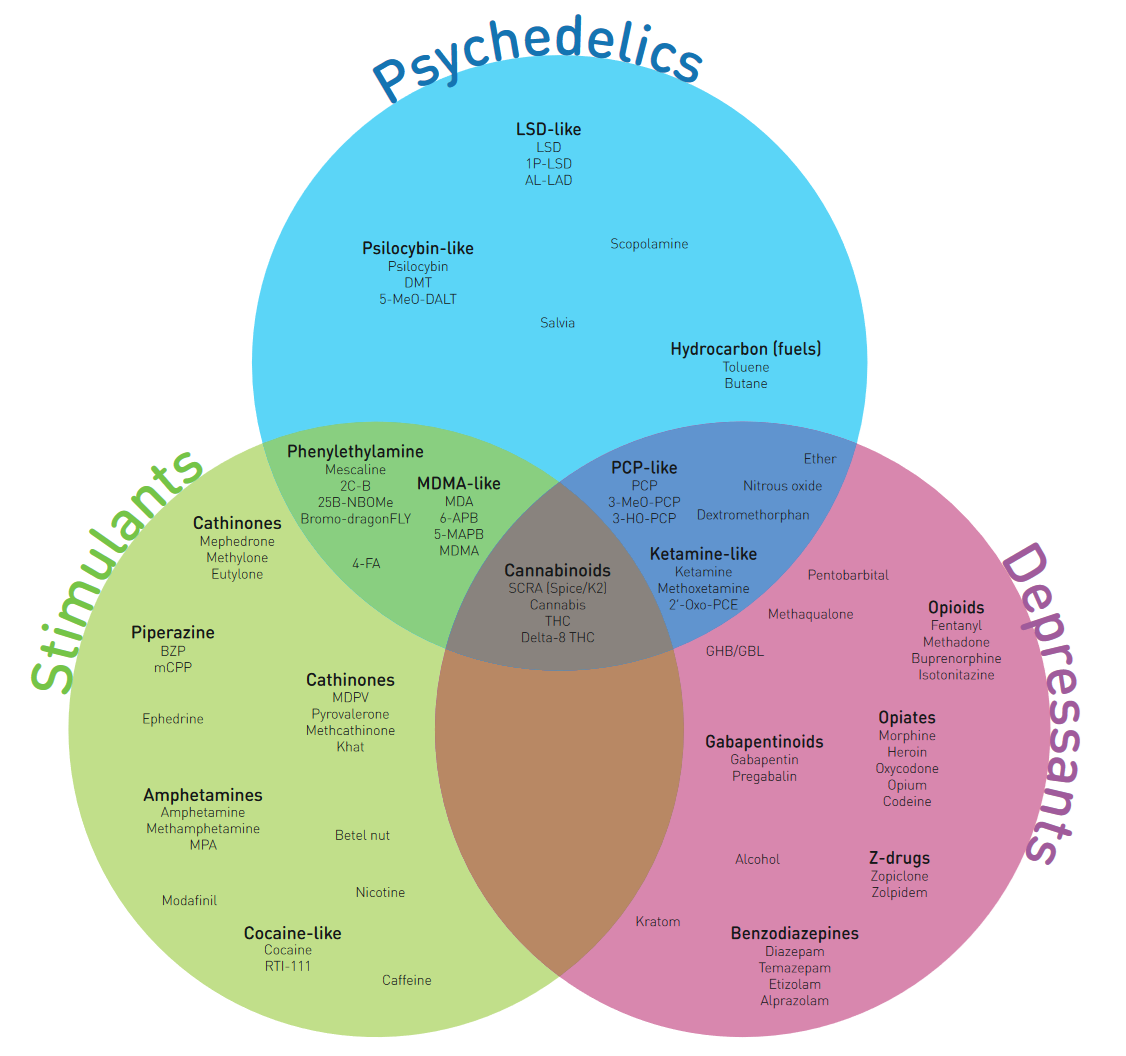Mark Adley and Guy Jones discuss three ways of visually representing drugs and their effects, and the strengths and limitations of these colourful taxonomies for education, treatment, and harm reduction.
Mark Adley is a PhD student at Newcastle University, researching the health and social care pathways of LGBT+ people who experience severe and multiple disadvantage in North East England. Guy Jones is Technical Lead at Reagent Tests UK and Senior Chemist at The Loop. The SSA’s Natalie Davies spoke to them via email about the Drugs Wheel, Drugs Pyramid, and Drugs Venn, which organise drugs into different categories, based on their effects and risks, as well as the article they collaborated on for Drugs: Education, Prevention and Policy with Fiona Measham, who is Chair in Criminology at the University of Liverpool and Co-founder of The Loop.
Natalie: You collaborated on an article with Fiona Measham, which explored how different drugs and their effects can be represented visually. What brought you together to write it?
Mark: “To be honest, I can’t remember when I met you, Guy. Maybe we were linked up in one of Mike Linnell’s groups (he moderates groups that disseminate harm reduction information about drugs)? I’m not sure exactly how we met, but it was sort of inevitable I think as we were moving in the same circles. Fiona got in touch with me to collaborate on a bespoke version of the Drugs Wheel for The Loop – now called the Club Drugs Wheel.”
“Without Guy (and sorry if this is embarrassing), the Drugs Wheel project would pretty much have ground to a halt a while back. My knowledge of chemistry and legal loopholes and nuances…has its boundaries…while Guy’s appears limitless.”
Guy: “Thank you Mark ☺ I sent an email in 2012-ish because I thought that Br-Dragonfly was incorrectly classified on the Drugs Wheel. It was an ambiguous case. However, the scheduling of 6-APB specifically showed that the Advisory Council on the Misuse of Drugs (ACMD) believed that this benzofuran structure required explicit mention and wasn’t covered by existing blanket legislation.”
Your article discusses three taxonomies of drugs – the Drugs Wheel, Drugs Pyramid, and Drugs Venn. Let’s start with the Drugs Wheel, which you developed in 2012. What was the inspiration behind this, and what would you say are its main strengths and limitations as a taxonomy?
Mark: “The inspiration behind it was…well, I was working with young people in the criminal justice system from around 2009, and by 2010, 2011, and 2012, we were seeing a significant increase in the use of ‘legal highs’ (as they were then known) – mephedrone being the first notable one, as well as some of the piperazines. So, it came about partly as I was delivering training, and partly as I was trying to explain to young people some of the effects and risks we were seeing of the different types of new drugs.”

The Drugs Wheel by Mark Adley aims to classify and simplify the range of psychoactive drugs in the illicit market. It includes new psychoactive substances and more established drugs. The image is published under a Creative Commons Attribution-NonCommercial-ShareAlike 4.0 International License, and is based on a work at www.thedrugswheel.com.
“The old models of substance awareness just didn’t fit for me. And I was constantly having to build this ‘other’ box for drugs such as MXE and the PCP derivatives and the synthetic cannabinoids and drugs like MDAI, which also didn’t fit anywhere.”
“So I was asking questions and through a simple twist of fate was put in touch with Harry Shapiro and Michael Linnell who invited me to join UK and Ireland DrugWatch – a group of highly respected and venerable professionals in the field (see members here). And, together, building on our work with people using drugs, and some very ‘out there’ conversations with ‘psychonauts’ on forums, we kind of all came up with the Drugs Wheel, and it evolved from there.”
“I think the model’s main strength for me is that it encompasses all drugs. There’s no need for an ‘other’ box. And it acknowledges the difference between dissociative and classical psychedelics, between the empathogens and stimulants, and creates a separate group for cannabinoids. It also has dual layers – dual rings – so you can then subdivide the categories for things like prescribed, or non-prescribed, legal or illegal, or under which legislation. So it allows for further adaptation.”
“I think its main limitation is its complexity. I think drug effects are a very messy, complex business. And while the model is all encompassing, I think for people from a lay background, or maybe younger people, or people with less drug experience, it might be a little overwhelming. I think also the model – because of its design – creates firm delineations or firm boundaries between drug categories that obviously don’t exist in real life.”
“I also think that most drugs within the empathogen category could be described as stimulants. But there are empathogens that don’t have a stimulant effect. And it was either put in the empathogen category, or into an ‘other’ group, so I opted for the former. In order to make a model that’s future-proof, empathogens needed to be included because they do have a separate action.”
You wrote that the Drugs Wheel has proven to be ‘more than an intellectual exercise’. How have you witnessed the Drugs Wheel being applied in practice, and did you make a conscious effort from the beginning to encourage its use or encourage people to share it?
Mark: “It was designed as a training tool, and I’ve used it quite extensively in training, as have others. Very early on in its use a young person’s prison worker dropped me an email and said they loved the model, but asked how we could make it more interactive. So at that point I designed the Drugs Wheel Game version, with help again from Michael Linnell who provided many of the drug labels. So the idea being that you place the blank board down on the table and you divide a group into two, and you allocate points for correct placement of category, and then drugs in the category etc.”
“That made it really interactive and quite fun. It made it into a bit of competition, which can be fun with young people, and then you could use that as a real learning point, as a way to have harm reduction conversations. The Loop use their version, the Club Drugs Wheel, at festivals and nightlife venues as a way of kick-starting conversations about harm reduction.”
What were the origins of the Drugs Pyramid?
Mark: “The Drugs Pyramid was co-designed by the venerable ‘Dr Nuke’ (Russell Newcombe) and Fiona Measham for a chapter in The SAGE Handbook of Drug and Alcohol Studies: Social Science Approaches.”

The Drugs Pyramid is a tiered model, that delineates between drugs with different psychoactive effects. According to Adley, Jones, and Measham, it was “primarily an intellectual exercise rather than an education, prevention, or treatment-oriented tool”. The pyramid was originally designed by Fiona Measham and Russell Newcombe, and adapted for the article in Drugs: Education, Prevention and Policy.
“Based on feedback from some frontline staff who preferred organising into stimulants, depressants, and hallucinogens, Fiona, Guy, and I explored how we might expand this model to also include established drugs.”
Guy: “There were a few challenges with the Drugs Pyramid when we started writing the paper – mainly challenges with conflating chemical structures and subjective effects as distinct categories, despite the fact that these aren’t always mutually exclusive.”
“After spending some time trying to tune the pyramid as it was, we felt that it was better to start with a new framework; this is when the idea of the Drugs Venn started to come into its own.”
Ah yes, tell me about the Drugs Venn…
Mark: “Our attempts with the Drugs Pyramid weren’t that successful. However, we still wanted to explore a way to address the two main criticisms of the Drugs Wheel – of it being overly complex, and having rigid categories that don’t highlight overlapping drug effects.”
“Fiona asked questions of Loop volunteers, some of whom felt that a Venn diagram might be the way forward – which led us to the Drugs Venn.”
“For me, its strengths are its simplicity, especially when working with young people. I’ve trialled this with a particularly (and wonderfully) feral group of young LGBTQIA+ people, which was both entertaining and informative (for both parties!). Its weaknesses? Well, adding another taxonomy might in itself add complexity, and for many workers, the Drugs Wheel marked a positive move away from the ‘stimulant, depressant, and hallucinogen’ model, which was felt to be too simplistic. In addition, grouping drugs by category can oversimplify the varying effects that can be found within their categories. It begs the question of whether the Drugs Venn is really suited for a more complex list of drugs, or whether that fits best with the Drugs Wheel – and so the cycle begins again!”
I saw on Twitter that you opened up the Drugs Venn for wider discussion. What was the nature of the feedback, and have you made any changes as a result?
Mark: “The amount of feedback was, well… that was quite a surprise… and maybe it just showed what lengths people will go to for a free t-shirt from The Loop! (laughs).”

The Drugs Venn incorporates features from the Drugs Wheel and Drugs Pyramid, as well as the Drugs World Venn by David McCandless. The image was designed by Mark Adley, Guy Jones, and Fiona Measham, and is licensed under a Creative Commons Attribution-NonCommercial-ShareAlike 4.0 International License.
“The feedback was really helpful…constructive and interesting, and led to some useful changes. I think especially so around a model that starts out trying to be simple, but then becomes complex.”
“Following the feedback, we made sure that the drug categories fit into a single section of the Venn, rather than overlapping. Another great idea from one Twitter user was a table at the bottom (see full image), giving a brief explanation of the effects in each of the categories, including the overlapping areas. These changes were incorporated into the design.”
“The Twitter discussion around the Drugs Venn also led to some joint work with Fiona Spargo-Mabbs and Nicholas Hickmott from the DSM Foundation, which was the driving force behind the creation of the young person’s versions of the Drugs Venn. There is now an interactive pdf version, as well as a blank version, which is particularly useful if workers don’t want to introduce young people to a wider array of drugs than necessary.”
You talked about the changing drug market in your article – for example, the proliferation of new psychoactive substances. How has this affected the requirements of a taxonomy, and what challenges does it present when trying to communicate the different types of drugs and their effects?
Mark: “I’m going to hand this over to you, Guy, because you do more of the adaptations for the Drugs Wheel than I do.”
Guy: “The drugs landscape is ever-changing in response to legislation and discoveries of new compounds, but a lot of those changes are responses to the nuances of different compounds rather than an indication of the need to create entire new substance classes. This means that most of the work is figuring out how new substances are related to old ones and determining which existing group they belong to, rather than needing to add new categories. After all, the human brain only has so many types of receptor that drugs can bind to!”
Mark Adley, Guy Jones, and Fiona Measham published an article in Drugs: Education, Prevention and Policy in April 2022. At the time of this interview going online, the article had over 3,800 views, and was reportedly the journal’s most-read article of 2022.
Interview edited by Natalie Davies
The opinions expressed in this post reflect the views of the author(s) and do not necessarily represent the opinions or official positions of the SSA.
The SSA does not endorse or guarantee the accuracy of the information in external sources or links and accepts no responsibility or liability for any consequences arising from the use of such information.

